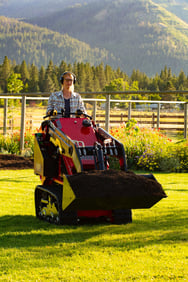Innovative Equipment Engineered to Last
Discover Barreto Manufacturing's 40 years of innovative, durable landscaping equipment, along with expert tips and local highlights for your projects.
Spring Cleaning
The optimism of spring uncovers the buildup of harsh winter months, and brings with it a bit of work to get your land whipped into shape. Debris buildup and soggy, overgrown gardens make for unsightly projects that need to be addressed before you can enjoy a pleasant and fruitful garden.
A few simple steps to help you tackle spring cleaning with ease:
1. Preparing
Most of the work is in the preparation. It’s important to clear your land of fallen limbs, windswept leaves, and any blown in litter, pine needles, and excess mulch - anything leftover from the winter season. You can start by raking up the debris into workable piles to be removed.
If preparing a garden, for most jobs a standard rear tine tiller will work your land nicely. The counter-rotating tines found on all-hydraulic tillers break up and aerate the soil while bringing nutritious soil closer to the surface. It’s also great for eating up weeds that survived winter because it removes the weed from the root and mulches it into the fresh earth.
 On larger projects, spring jobs may be better suited to a mini track loader. The compact and versatile design allows for low-impact maneuverability in your outdoor space and provides many attachment options. Bucket and tilling attachments are common choices,
On larger projects, spring jobs may be better suited to a mini track loader. The compact and versatile design allows for low-impact maneuverability in your outdoor space and provides many attachment options. Bucket and tilling attachments are common choices,
or a grapple attachment can help if working to remove brush. Tilling attachments can clear stubborn weeds from large areas, and bucket attachments quickly transport heavy loads of mulch, sod, and more. Read more about Mini Skids and the Top 3 Benefits They Offer.
Next, be sure to prune bushes and trees. Controlling the health, shape, and size of your woody plants starts with this simple process and a good pair of clippers. Depending on the type of plant, trimming up unruly bushes and trees in early spring can help encourage new growth and remove any dead or damaged pieces that inhibit growth. Helpful instructions can be found here for Bush Pruning Tips for Healthier Bushes. Recycling this material into mulch can then protect and finish your garden.
2. Mulching
Mulch is like the perpetual gardener - it keeps working long after you’ve pulled your boots off and called it a day. Mulching organic material not only clears those piles of debris from your spring cleaning, but it also provides essential ground coverage to continually  protect and hydrate your plants. Mulch prevents and controls weeds, protects the root systems of your plants, and reuses material you already have while adding diversity back to the soil. Sending yard debris through a mulcher is a great way to process bulky organics on-site with minimal effort.
protect and hydrate your plants. Mulch prevents and controls weeds, protects the root systems of your plants, and reuses material you already have while adding diversity back to the soil. Sending yard debris through a mulcher is a great way to process bulky organics on-site with minimal effort.
Keep in mind the differences between mulchers and chippers - mulchers are designed to process compostable materials, like leaves and bush trimmings. Chippers are designed for woody, rigid materials like tree branches and stumps. Some machines, like the 3104CMS Chipper Mulcher Shredder, do both, with separate hoppers for chipping and mulching within the same unit.
3. Planting
 Planting is a breeze now that you have a clear canvas to work from. With debris removed, land prepared, and finishing mulch at the ready, you can focus on placing your favorite veggies and decorative plants in the garden and surrounding landscaping. If planting a garden, visit our 5 Tips for a Successful Vegetable Garden to help plan your next steps. It’s important to take into account time of year, plant variety, location, and soil conditions when selecting seeds or starters. From large to small spaces, planning your garden and tilling up the earth before sowing sets your seeds up for success.
Planting is a breeze now that you have a clear canvas to work from. With debris removed, land prepared, and finishing mulch at the ready, you can focus on placing your favorite veggies and decorative plants in the garden and surrounding landscaping. If planting a garden, visit our 5 Tips for a Successful Vegetable Garden to help plan your next steps. It’s important to take into account time of year, plant variety, location, and soil conditions when selecting seeds or starters. From large to small spaces, planning your garden and tilling up the earth before sowing sets your seeds up for success.
With a little work and the right tools, spring cleaning is an essential step to a healthy outdoor environment. Plan for debris removal and get creative with the ways you reduce, reuse, and recycle organic material for a better landscape.
